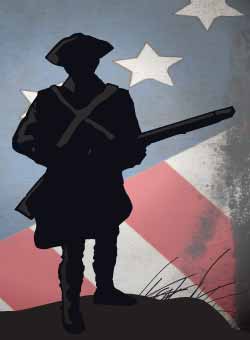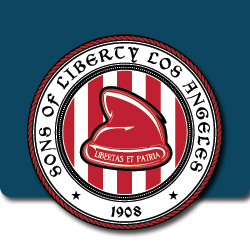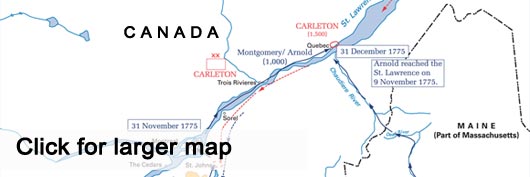
huzzah! The Liberty Tree's 30th Year!
Newsletter content below: just click on a title bar to open the story.

This year’s Massing of the Colors and Salute to Our Armed Forces was one of the best in recent memory. This event has always been about the great young people who participate in college ROTC and High School JROTC programs, and this year 23 ROTC/JROTC units participated, along with color guards from active Army, Marine and Air Force units. When you add in the more than 25 Sons of the American Revolution color guard units and reenactment groups, a large contingent of US Volunteers-Joint Services Command members, and lineage society members, over 200 individuals participated. It was quite a display for the more than 200 spectators!

A first at this Massing was the participation of t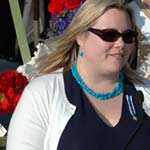 he Hollywood Chapter, Daughters of the American Revolution, celebrating their 100th year, and Sarah Kaiman, the Chapter Regent, brought greetings. Many other DAR chapters were represented, and we hope this is a trend that will grow. There is no organization that works harder to keep the memory of the Revolution alive, and the SAR benefits tremendously from their efforts.
he Hollywood Chapter, Daughters of the American Revolution, celebrating their 100th year, and Sarah Kaiman, the Chapter Regent, brought greetings. Many other DAR chapters were represented, and we hope this is a trend that will grow. There is no organization that works harder to keep the memory of the Revolution alive, and the SAR benefits tremendously from their efforts.
Also participating were: Brigadier General Stehen Kirtley, who provided the Invocation; Compatriot Jim Blauer, who lead us in our National Anthem; Western Region Vice President General Stephen Renouf, who brought greetings from the National Society, Sons of the American Revolution; Reverend Lou Carlson, who brought greetings from the California State Society, SAR; Dominick DiCesare, who brought greetings from the California State Society, Children of the American Revolution; Steve Clugston, who portrayed General George Washington, Master Chief Frank Contreras, who lead the flag-folding ceremony, Reverend Gary Dickey, who played the Great Highland Bagpipe throughout the event, the entire corps of Morgan's Rifle Company, who provided the musket salute, Cap Cresap and Col. John Lamb's Artillery Company, who provided the artillery salute, and Commander McKinney, who provided the Benediction.

This event, sponsored every year by the Sons of liberty Chapter, Sons of the American Revolution, is the largest event of its kind in the western US, and it takes a tremendous amount of work to put on. We appreciate the effort it takes for every participant to prepare and participate. The event lasts only an hour, but untold hours go into making that one hour a success. Thanks to every one of you.
This year's ROTC/JROTC Participants included (I know there were more, but you didn't sign in):
| Woodrow Wilson HS JROTC | Jordan HS JROTC |
| Washington HS JROTC | James Monroe HS JROTC |
| Verdugo Hills HS JROTC | Gladstone HS JROTC |
| USN Sea Cadets Sherman Oaks | Fairfax HS JROTC |
| USN Sea Cadets | Crescenta Valley HS AFJROTC |
| UCLA Army ROTC | Crenshaw HS JROTC |
| Poly HS AFJROTC | Cleveland HS JROTC |
| Narbonne HS NJROTC | Carson HS JROTC |
| Manual Arts HS JROTC | Belmont HS JROTC |
| Los Angeles HS JROTC | Asuza HS JROTC |
| Littlerock HS JROTC | Abraham Lincoln HS JROTC |

Non-ROTC/JROTC organizations participating:
| US Volunteers/Joint Services Command | Kern Valley SAR |
| Temescal Chapter DAR | Juan Crespi CAR |
| South Coast SAR | Juan Bautista de Anza Society CAR |
| Sons of Union Veterans | Irvine Ranch Chapter DAR |
| SMC | Hollywood Chapter DAR |
| Second Light Dragoons | Continental Artillery |
| Riverside SAR | CASSAR |
| Order of Founders & Patriots | CASCAR |
| NSSAR | CAR |
| Morgan's Rifle Company | American Legion Post 193 |
| Mission Viejo DAR | 29th Regiment of Foot |
| March Total Force Honor Guard | 23rd Regiment RWF |
| Lee's Legion | Col. Lamb's Artillery |
As with any organization or event, there are a few individuals who merit an extra word of thanks for effort that exceeded every expectation. Without them, the event would not have been the success that it was:
- Compatriot and Color Guard Commander Lowell Downer, whose personal effort resulted in the best ROTC/JROTC participation in years.
- Jennifer Bishop, who runs the check-in table every year.
- Brigadier General Stephen Kirtley, who orchestrated participation of the many USV-JSC volunteers who presented the Invocation, Benediction, Flag Ceremony, inspected the troops, and brought an air of dignity to the entire event. Thank you all for your service.
- The entire Morgan's Rifle Company, who steped up when we needed help and directed all the color guards at the assembly and pass-in-revue.

Enjoy the three slide shows below. Click a menu bar to start that show. Thank you to our photographers, Compatriot Ron Johnson and Evan Bohannon. You can request copies of individual photos from the webmaster on our contacts page.
To further the study of the American revolution, your webmaster is reviewing out-of-print texts to bring quality scholarship to you. Over the next months, I will publish a commentary on each battle of the Revolution in order of occurrence.
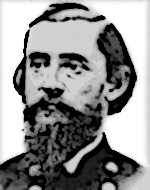
The author of each is Colonel Henry B. Carrington, MA, LLD, who wrote "Battles of the American Revolution 1775-1781." Published by AS Barnes & Company in 1876. The work is in the public domain, and not subject to copyright. He was professor of natural science and Greek at the Irving Institute in Tarrytown, New York, from 1846 to 1847. Under the influence of the school's founder, Washington Irving, he wrote "Battles of the American Revolution." Carrington subsequently became adjutant general for Ohio, mustering ten regiments of militia at the outbreak of the Civil War and organizing the first twenty-six Ohio regiments. Learn more>>

EXPEDITIONS TO QUEBEC AND MONTREAL. THEIR VALUE.
On the seventeenth day of September, 1775, Arnold's command marched from Cambridge to Bedford; sailed from Newburyport on the nineteenth, and on the twentieth, entered the Kennebec river, and landed at Gardner, Maine.
A small scouting party was sent forward to blaze the trees, and thus mark out a route to Lake Megantic, at the source of the Chaudiere river; and another party was dispatched to Dead river to select the best point for transferring the bateaux from the Kennebec. A glance at the map, "Outline of the Atlantic coast," will indicate the route pursued.
Morgan's corps of riflemen was assigned to the advance, and started on the twenty-third day of September. The rest of the command embraced three divisions, which marched at a day's interval between them, each having charge of its own support. Lieutenant-colonel Enos with three companies commanded the rear division.
The progress of the army was impeded by a swift current, and from the third day it became necessary for men to wade in deep water and force the boats along by manly strength. Upon reaching Norridgewock Falls, the real difficulties of the march began. Seven days were consumed in carrying the boats and provisions around the falls, a distance of only a mile-and-a-half. Precipitous rocks bounded the river on either side, and the transfer was not completed without injury to boats as well as provisions. The swift current of the river was confined within closer banks as they advanced: the eddies and exposed rocks rendered it necessary almost daily to drag or carry the boats along the shore, and on the tenth of October, when the army reached the divide between the Kennebec and Dead rivers, it was found that the force had been reduced by desertion and sickness to nine hundred and fifty effective men.
On the thirteenth of October, Arnold wrote to the commander of the expedition from Ticonderoga, giving his plans, and also sent an Indian messenger to his correspondents at Quebec, with report of his purpose and progress. This messenger betrayed his trust.
The march of fifteen miles across to Dead river was one of severe trial. Three shallow ponds which were choked with fallen trees, many ravines, quagmires, and swamps, lay in the way ; the mud was often knee deep, the water was up to the arm-pits; and even when oxen were used for hauling, the men were required to render aid and extricate the loaded boats from the mire.
October fifteenth, the boats were launched into Dead river, a comparatively still stream, but broken by shallows, falls, and ripples, so that in a distance of eighty-three miles, the boats had to be carried seventeen times, with constant loss of supplies and injury to the boats. Men deserted daily, some froze to death, others who were sick were left behind in charge of one or two convalescents, and still the army moved on.
October twenty-second, rain fell in torrents.
October twenty-third, continued rain raised the river nearly eight feet seven boats were overturned and their contents lost. Rations for only twelve days remained on hand, and the army was still thirty miles from Lake Megantic.
A council of war was held. Orders were sent to Lieutenant-colonels Green and Enos to forward every able bodied man for whom rations for fifteen days could be made up, and to send all others back to Norridgewock Falls. Enos, short of provisions, as he afterwards claimed, marched his division of three companies back to Cambridge.
Suddenly rain changed to snow! The ponds froze over, and the ice had to be broken with the butts of muskets to effect a passage for the boats.
The barges had been hauled one hundred and eighty miles, and had been carried forty miles. The men began to go without shoes. Clothing was in rags; their limbs were torn by briars; provisions became scarce; their dogs were eaten for food as well as all their cattle; fish, plants, and roots made up their chief diet. Blankets not worn out, were continually wet or frozen, and hemlock boughs supplied the demand for shelter and bedding. Marvellous was the endurance of those men; and as if in his element, Arnold's courage never abated, his confidence in success never failed him. It was indeed a great ordeal, but a great triumph would compensate for the suffering, if it only secured the surprise of Quebec and the conquest of Canada.
Marvellous was the endurance of those men; and as if in his element, Arnold's courage never abated, his confidence in success never failed him. It was indeed a great ordeal, but a great triumph would compensate for the suffering, if it only secured the surprise of Quebec and the conquest of Canada.
For three days the army rested near Mount Bigelow. A quaint tradition is cited by Lossing, which asserts, "that this officer whose name is still identified with the mountain, visited its top to behold the towers of Quebec."
Lake Megantic was reached, and another inventory of supplies was taken. Less than three days' rations remained. Starvation seemed to be the inevitable destiny of the entire command.
October twenty-seventh, Arnold started with five boats, some dug-out canoes, and less than seventy men, to seek the nearest French settlements for the purchase of provisions. The government had furnished him with a thousand dollars before his departure, so that he felt confident of success among the French provincials. The Chaudiere river flowed with impetuous velocity, three of the boats were dashed in pieces upon rocks, and the party were in the utmost peril.
October thirtieth, they reached Sertigan, seventy miles from Lake Megantic, were kindly received, purchased flour and cattle, and sent them back to the army in charge of some Canadians and Indians. In a few days, the troops, having lost all their boats, gathered by small detachments at Sertigan, and the army, reunited, was within twenty-five miles of Quebec. For thirty-two days of that march, no human being had been met with in the wilderness, and the trail made by the troops was obliterated as soon as made. Retreat had become worse than to advance.
November ninth, the remnants of the expedition reached Point Levi, opposite Quebec, and there established their base of operations for the conquest of Canada. But the garrison of Quebec, small as it was, had been forewarned; the outworks were undergoing repair, and all boats had been removed to the other side of the river. An immediate advance just at that time, might have secured the capture of the city. The garrison, or such officers as had been entrusted with the news of Arnold's expedition, had no faith in his ability to complete his march, and the people were so apprehensive that resistance would involve the ruin of the city, that the opportunity was ripe for an immediate and bold assault. But Arnold had to build, capture, or pur- chase boats before he could advance to conquest. His resolution was still equal to the emergency, and the men were put at work.
As if to test his endurance to the utmost, a furious tempest of wind, rain, and sleet set in, and the army was again in peril. He might overcome the terrors of the wilderness, but the tempest was his master!
The expedition to Montreal was being organized at Ticonderoga, when the attention of the reader was invited to Arnold's journey through the wilderness.
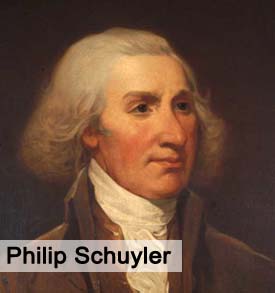 General Schuyler's ill health greatly retarded operations, and he soon found that the strength of the army which was hastily gathering at that post was only in mere numbers and the physical capacity of individual men. There was no discipline, no respect for officers, but a perfect independence of thought, judgment, and action, with no time for proper preparation and instruction. Unless the advance could be nearly simultaneous with that of Arnold, both expeditions would lose the objective in view.
General Schuyler's ill health greatly retarded operations, and he soon found that the strength of the army which was hastily gathering at that post was only in mere numbers and the physical capacity of individual men. There was no discipline, no respect for officers, but a perfect independence of thought, judgment, and action, with no time for proper preparation and instruction. Unless the advance could be nearly simultaneous with that of Arnold, both expeditions would lose the objective in view.
It is just here that some attention may be given to the theory which led General Washington to authorize these demonstrations against Canada.
He believed that the occupation of Montreal and Quebec, while they were almost destitute of regular troops, and the season of the year precluded reinforcements from England, would afford the best opportunity for testing the people of Canada, and would also furnish them a basis for the assertion of independence, if they were ripe in sentiment for such a movement. His well-conceived circular addresses which were largely distributed, as well as the policy which he enjoined upon the officers and men of both expeditions, were eminently wise and inspiring. He judged the Canadian opponents of British policy by the expression of feeling which pervaded the colonies, and assumed that very many would gladly avail themselves of the opportunity which the presence of colonial troops would afford for throwing off the yoke of the mother country.  It seemed clear that General Carleton, having no fears for Quebec, would concentrate at Montreal all effective forces for the recovery of Ticonderoga and Crown Point. Upon the supposition that Carleton's troops did not exceed seven or eight hundred regulars, and as many provincials, he decided that an army of three thousand men would be adequate for operations from Lake Champlain to Montreal. This estimate was a correct one. Popular demonstrations had indeed been made in the portion of Canada lying south from Montreal, wbich indicated sympathy with the American movement. This expression of feeling, however, was rather for the purpose of keeping on friendly terms with the American troops who threatened the border, than to indicate their readiness to take up arms for themselves as a people.
It seemed clear that General Carleton, having no fears for Quebec, would concentrate at Montreal all effective forces for the recovery of Ticonderoga and Crown Point. Upon the supposition that Carleton's troops did not exceed seven or eight hundred regulars, and as many provincials, he decided that an army of three thousand men would be adequate for operations from Lake Champlain to Montreal. This estimate was a correct one. Popular demonstrations had indeed been made in the portion of Canada lying south from Montreal, wbich indicated sympathy with the American movement. This expression of feeling, however, was rather for the purpose of keeping on friendly terms with the American troops who threatened the border, than to indicate their readiness to take up arms for themselves as a people.
Arnold had freely declared his opinions, and claimed to have positive knowledge, that the provincials desired to act in full concert with the American forces. The occupation of Montreal was therefore regarded as both practicable and wise; and it was near enough to the Sorel river and Lake Champlain to be well supported, so long as the British army was not augmented along the Atlantic coast.
There was still another consideration. The navigable waters of the St. Lawrence exposed Montreal, which was on the north side of the river, to naval attack; and the strategical character of Quebec was so positive, as to make the occupation of any part of Canada very hazardous, so long as that fortress was left for a base and rendezvous of British armies and fleets. Thus the capture of Quebec, as well as of Montreal, was necessary to any substantial control of Canada itself. The concurrence of Washington in the proposed expedition of Arnold, was therefore predicated upon the possibility of striking quickly, and by surprise, before a substantial defense could be interposed, and did not provide for the contingency of a formal siege. No artillery was furnished, because not within the scope of the proposed duty, and its transportation would have been impossible.
Upon the assumption that Congress was rightly advised of the sentiments of the Canadian people, the expedition was rightly planned. As a matter of history, its signal failure repressed the public avowal of Canadian sympathy with the American Revolution, and demonstrated the bad policy of attempting such distant enterprises as were not essential to colonial defense proper.
Still another element entered into the calculations of the American Congress and affected its action. That body early in June, disclaimed all purpose to operate against Canada.
Bancroft states, that the invasion of Canada was not determined upon until "the proclamation of martial law by the British governor, his denunciation of the American borderers, and the incitement of savages to raids against New England and New York, had made that invasion a substantial act of self-defense."
The letters of Washington to Schuyler, Arnold, Wooster, Montgomery, and to Congress, show clearly that he estimated the difficulties that attended both expeditions, and the contingencies which awaited their execution.
Washington wrote earnestly on the fifth of October, "that if Carleton is not driven from St. John's, so as to be obliged to throw himself into Quebec, it must fall into our hands, as it is left without a regular soldier, as the captain of a brig from Quebec to Boston says. Many of the inhabitants are most favorably disposed to the American cause, and that there is there the largest stock of ammunition ever collected in America."
A second letter of the same date states that "Arnold expected to reach Quebec in twenty days from September twenty-sixth, and that Montgomery must keep up such appearances as to fix Carleton, and prevent the force of Canada from being turned on Arnold," but, "if penetration into Canada be given up, Arnold must also know it in time for retreat." And again, " This detachment," Arnold's, " was to take possession of Quebec if possible; but at any rate to make a diversion in favor of General Schuyler."
The narrative will now follow the second expedition in its course.
In spite of bad health, Schuyler worked vigorously to hasten the organization of his army.
The Green Mountain Boys reorganized on the twenty-seventh of July, and elected the gallant Seth Warner as their lieutenant-colonel, in place of Ethan Allen. Boats were built with great rapidity, and yet, as late as the sixth day of August, the maximum force that was willing to cross the border did not exceed twelve hundred men, and the supply of powder was insufficient even for these. Washington then wrote to Schuyler: "In the article of powder we are in danger of suffering equally with you."
Meanwhile, Major John Brown, a discreet and brave officer, had been sent to Canada to learn the condition and disposition of the British troops. On his return about the middle of August, he reported the number of regulars in Canada to be about seven hundred men; that nearly half this number was at St. John's, and that the Canadian militia were disaffected towards their officers, who had been purposely selected from the old French nobility of the frontier.
On the seventeenth day of August, Montgomery arrived at Ticonderoga.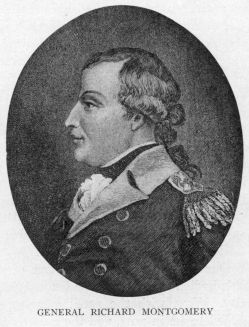
Upon receiving a letter from Washington that "not a moment of time was to be lost," Schuyler suspended his negotiations with certain Indian tribes whom he had met in council at Albany, and joined the army. The first objective point of importance was the reduction of St. John's, already well garrisoned, and greatly strengthened since the visit of Arnold in the spring.
Montgomery started with a little more than a thousand men, but was so retarded by storms as not to reach Isle La Motte until September third. On the fourth Schuyler joined him, and they advanced to Isle Aux Noix. On the sixth they embarked for St. John's. The enterprise, undertaken without artillery, failed, as did a second attempt of a similar force on the tenth.
Schuyler's ill health compelled his return to Ticonderoga, but with infinite resolution, system, and patience, he pushed forward supplies to Montgomery, who assumed the active command with a force aug- mented to about two thousand men. Week after week passed by, and little progress was made in the reduction of the fort. The difficulties of his position were mainly those of discipline. All wanted a voice, and few recognized the fact that in a regiment of five hundred men, there could not be five hundred colonels. The single question of the location of a battery was made to hinge upon what the men, not the commander, deemed best. An unauthorized and unfortunate enterprise occurred just at this moment, still more to embarrass the army.
Ethan Allen was endeavoring to recruit Canadian volunteers near Chambly. After partial success, and without consulting Montgomery, he resolved to surprise Montreal as he had captured Ticonderoga. He failed, was taken prisoner by General Prescott and sent to England. His hasty enterprise, undertaken with inadequate forces, compromised many Canadians, and repelled others who had been ready to join his command.
On the twenty-sixth of October, General Washington wrote to Schuyler the following consolatory words: "Colonel Allen's misfortune will, I hope, teach a lesson of prudence and subordination to others who may be too ambitious to outshine their general officers, and regardless of order and duty, rush into enterprises which have unfavorable effects on the public, and are destructive to themselves." Justice to Allen requires the statement that Major Brown had pledged his aid in the enterprise, and to furnish two hundred men Brown had assured him that Montreal was practically defenseless Allen crossed the St. Lawrence from Longuenil, September twenty-fourth, upon the supposition that Brown had crossed the river higher up, and was waiting for his arrival. Major Brown must have known that such an enterprise needed Montgomery's sanction, and was unwise; but his failure to support Allen, compelled the latter to fight against overwhelming numbers. General Carleton also collected nearly a thousand Provincial militia, but their desertion was so immediate that he was soon left with only a nominal command of less than three hundred men. At this juncture he wrote to General Howe that "the Americans had poisoned the minds of the Canadians."
On the eighteenth day of October, Major Brown, aided by many citizens, then organized as a battalion under James Livingston of New York, who had resided at Chambly, and was very popular with the people, captured the fort at that place, sent the prisoners to Connecticut, and turned over to the American army the trophies, which included nineteen cannon, and most valuable of all, one hundred and twenty barrels (six tons) of powder.
General Wooster arrived just at this time, approved of Montgomery's general plans, aided him to advance his batteries to a commanding position, and thereby made the investment of St. John's complete. The garrison had no hope except from Canada.
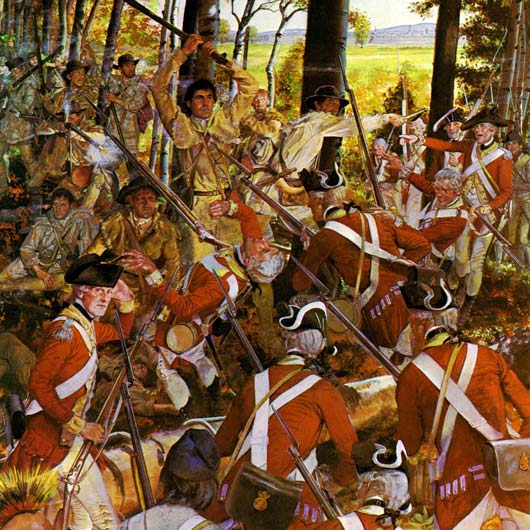
General Carleton had by this time again collected a mixed and unreliable force of nearly eight hundred men, and made an attempt to cross the St. Lawrence at Montreal, but was thrust back by Warner's Green Mountain Boys, and a portion of the second New York regiment. On the third day of November the garrison of St. John's, consisting of nearly five hundred regulars, more than half the British regular force then in Canada, and a hundred Canadians, became prisoners of war, among them Andre, and this siege of fifty days ended.
As an evidence of the peculiar state of the regiments at that time, it is to be noticed that one of them mutinied because Montgomery allowed the prisoners to retain their extra suit of clothing, instead of treating it as plunder.
On the twelfth of November, Montgomery took possession ot Montreal, and the expedition of the left zone of operations attained its objective.
The British flotilla was also captured, together with General Prescott, the captor of Allen, but General Carleton escaped under very favoring circumstances, and thus was enabled to participate in the defense of Quebec.
The Chapter needs your input! In viewing other SAR Chapter sites, I came across something that’s a great idea: publishing the biographies of the Chapter member’s Patriot Ancestors. This is not only of interest to the other Chapter members, it serves as an important resource to our cousins out there who are searching for their ancestors. What better way to honor the memory of those who sacrificed for our nation’s founding that to tell their story.
The reason I chose the illustration of a faceless patriot used for our web site is that most of us do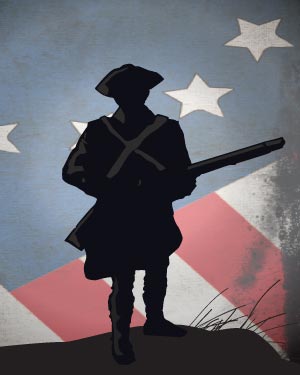 n’t know what our ancestors looked like. Their features are lost to us. However, with a little work, we can all find out where they were and what their life was like at the time of the Revolution, based on contemporary accounts of the people around them. This brings them to life and makes the Revolution more real to all of us.
n’t know what our ancestors looked like. Their features are lost to us. However, with a little work, we can all find out where they were and what their life was like at the time of the Revolution, based on contemporary accounts of the people around them. This brings them to life and makes the Revolution more real to all of us.
So, I invite all Chapter members to submit a biography for each of their Patriot Ancestors. Each can be as long or as short as you like (that’s another advantage of the Web). You can use illustrations as well, but keep in mind the must be your own photos, or images in the public domain.
We already have some posted on our Web site, so take a look and get started on yours today!
